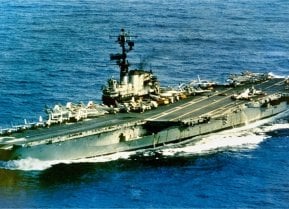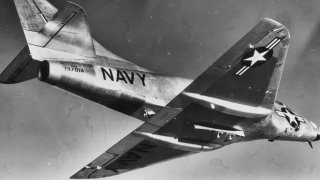A-4 Skyhawk: The Warplane That Freaked Out America's Enemies
The A-4 was designed as an attack aircraft to replace the Douglas AD Skyraider (A-1). The Navy sought a lightweight platform that was simple and inexpensive, which Douglas Aircraft developed. The A-4 cost roughly $800,000 dollars, less than the Navy’s $1 million budget for the unit
Dubbed the Tinker Toy because of its small frame, the American-made A-4 Skyhawk exemplified the U.S. Navy’s strike capabilities during the Vietnam War.
The single-seat subsonic carrier-capable airframe entered service with the Navy Marine Corps in the early 1950s and became known for its striking accuracy against ground targets.
For nearly half a century, the Skyhawk was deployed frequently in combat and retains quite a legendary status among aviation buffs.
In addition to being the airframe that dropped ordnance during the Vietnam War, the A-4 saw combat in the 1973 Yom Kippur War, the Falklands War, and Operation Desert Storm. The Skyhawk has been flown by a wide array of nations, including Argentina, Israel, Brazil, Australia, Kuwait, Malaysia, and Singapore.
An Overview of the A-4 Skyhawk’s History
The A-4 was designed as an attack aircraft to replace the Douglas AD Skyraider (A-1). The Navy sought a lightweight platform that was simple and inexpensive, which Douglas Aircraft developed. The A-4 cost roughly $800,000 dollars, less than the Navy’s $1 million budget for the unit.
Additionally, the Skyhawk weighed approximately half of the 30,000 pounds specified by the Navy. Design-wise, the A-4 featured a small delta wing that did not necessitate a heavy wing-folding mechanism like previous attack airframes. This attribute made it easier to store on aircraft carriers.
Speed-wise, the Skyhawk was very quick in the car. Often dubbed Heinemann’s Hot Rod after the airframe’s lead designer, the A-4 set a world record of more than 695 miles per hour in the mid-1950s. The first Skyhawks were powered by 7,200 lb-thrust Curtiss-Wright J65-W-2 engines.
As successive A-4 iterations evolved, heftier 7,700 lb-thrust J65-W-4 engines were used. In addition to being able to carry a variety of missiles, bombs and other munitions, the Skyhawks could also deliver nuclear weapons using a low altitude bombing system by way of a loft delivery system.
The A-4 Skyhawk’s Debut in Vietnam
After American destroyers were attacked in the Tonkin Gulf in 1964, Skyhawks participated in the first strikes of the Vietnam War. Notably, 2008 presidential nominee and late U.S. Senator John McCain flew one of the A-4s that were shot down during the war, resulting in his five-and-a-half-year experience as a prisoner of war in the notorious Hanoi Hilton.
As detailed by the Navy, “In the skies over Vietnam, Skyhawks logged more combat missions than any other naval aircraft, including notable strikes against bridges and power plants in North Vietnam and close air support of troops engaged in ground combat in South Vietnam.
Among those who flew the aircraft was Lieutenant Commander Michael Estocin, who during a flight on April 20, 1967, neutralized three surface-to-air missile sites in a strike over Haiphong, North Vietnam and subsequently made a fiery carrier landing in his badly damaged A-4. Shot down five days later, he received the Medal of Honor posthumously.”
Roughly 3,000 Skyhawks were produced over 23 years. The Navy ultimately retired the A-4 Skyhawk in 2003, but the powerful attack aircraft maintains an honorable track record.
About the Author
Maya Carlin is an analyst with the Center for Security Policy and a former Anna Sobol Levy Fellow at IDC Herzliya in Israel. She has by-lines in many publications, including The National Interest, Jerusalem Post, and Times of Israel. You can follow her on Twitter: @MayaCarlin.


